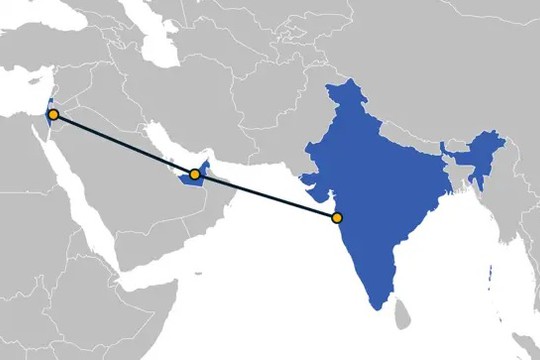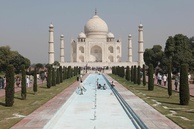During the G20 summit in India, several countries rolled out another “alternative” to China’s “Belt and Road Initiative” (BRI) project, which Beijing has been promoting for many years now. What are the prospects for the Middle East Corridor?
The plan was unveiled in New Delhi by Indian Prime Minister Narendra Modi, US President Joseph Biden, Saudi Arabian Prime Minister Mohammed bin Salman, UAE President Mohammed bin Zayed, EU Commission President Ursula von der Leyen, German Chancellor Olaf Scholz, French President Emmanuel Macron and Italian Prime Minister Giorgia Meloni.
The logistics idea behind the “Middle East Corridor” is that it should stretch from India through the UAE, Saudi Arabia, Jordan and Israel (pic.) to Europe. Containers from India will reach the UAE ports by sea and will then be placed on railway platforms and delivered to Haifa in Israel, where they will be loaded onto ships again and sent to Piraeus in Greece. Each country participating in the project is supposed to finance the construction and modernization of transport infrastructure on its territory. Some South Asian states may later join the “corridor.”
According to The Hindustan Times, India, the UAE, the US, KSA and European countries - France, Germany and Italy - played a leading role in designing the project. The final draft was agreed upon following several hush-hush meetings between the national security advisers of India, the UAE, the United States and with the support of the Crown Prince of Saudi Arabia, Mohammed bin Salman. “Conceived two and a half years ago,” the project received a nod of approval from the G7 as part of its 2021 infrastructure initiative, which was “relaunched” as the Partnership for Global Infrastructure and Investment (PGII) in June 2022, during a summit in Elmau, Germany.
The port of Fujairah will serve as the main transshipment center of the “Middle East Corridor” in the UAE and will link up with Israel’s Haifa by a 2,650-kilometer railway running through Saudi Arabia and Jordan. Meanwhile, 1,850 kilometers of railway tracks are already in operation, and Riyadh plans to build the remaining stretch. In turn, an Indian operating company is already modernizing the port of Haifa. From Israel, cargo will be sent to various ports in Europe, including Italy, Germany and France. Construction of the “corridor” will be done in stages and they even plan to eventually convert rail engines to solar energy. The “corridor” is supposed to supply goods to Europe not only from India, but also from Vietnam, Bangladesh, Myanmar and other regional countries. The project’s initiators expect the delivery time for a standard container from the west coast of India to Europe to be about 72 hours. [i]
The Russian specialist telegram channel “Gruzopotok” [ii] has strong doubts about the economic feasibility of the project. “Logistics is developing for three reasons: to make transportation cheaper, faster and cargo volumes larger. Just which of these objectives the Middle East corridor can solve is anyone’s guess. There is a traditional route through Suez. Now they are proposing to abandon it by including two (!) additional transshipments. This could make sense in the event of a potential closure of the Suez Canal.”
In turn, the participants in this project make no secret of the fact that one of its main goals is to develop logistics routes alternative to the China’s “Belt and Road” global infrastructure initiative. However, it looks like there is more to the intentions of the countries willing to join the Middle East Corridor project than meets the eye. And these goals are not necessarily identical.
Indian media insists that the initiative to form a new “corridor” belongs to New Delhi. The Indian economy is experiencing high growth rates and with the international configuration now changing fast, New Delhi is trying to play an increasingly decisive and responsible role in global affairs and to become “a link between the West and the global South.” Ideally, to challenge China’s role as the informal leader of the non-Western world. Realizing the trend towards de-globalization, primarily through the establishment of macro-regions, India intends to join the club of the creators of the Greater Middle East in a bid to offset the influence of the two other areas – Greater Central Asia and Greater East Asia, which New Delhi believes play a key role from the standpoint of its strategic interests.
Saudi Arabia, for its part, views the new “corridor” as an additional route for trade with China and a strong bargaining chip in relations with Beijing. Indeed, the potential new route could effectively undercut China’s role in the development of trade relations between East and West. Since without the participation of Riyadh the “Middle East Corridor” loses its meaning, the “keys” to it will largely end up in the hands of the Saudis. On the other hand, relations between Saudi Arabia and Beijing are developing very dynamically and across the board. In March, state oil giant Saudi Aramco announced two major deals aimed at increasing its multibillion-dollar investment in China and cementing its role as China's top oil supplier. Against the backdrop of their warming political relations, cooperation between Riyadh and Beijing is also expanding in the field of security and “sensitive” technologies.
Following Washington’s lead, Europeans too are seeking to rebuild supply chains so that they become less dependent on any single non-Western supplier, primarily China. However, there is a growing awareness that the potential benefits of such policies come at a high price for most countries, which will have to join the global “subsidy race,” spend billions of dollars in government outlays designed to preserve existing industrial production and attract companies from the most advanced sectors. Moreover, the more a Western country, such as Germany, depends on “hostile” economies, the less competitive it may become in the event of a complete break with the latter.
Another participant in the “corridor,” France, views the development of relations between the European part of the West and the East differently from the way the Americans see it. According to Paris, in the Indo-Pacific region there is an obvious clash between the interests of the Old World and the requirements of transatlantic interaction. France wants Europe to play a special role in this region, distinct from that of the United States. A number of statements made in recent years by the French Ministry of Europe and Foreign Affairs can be interpreted as the country’s unequivocal intention to “defend the third way” that would be free from the constraints of artificial restrictions of “bloc thinking.”
As for the United States, it has been nurturing the idea of “creating alternatives to Chinese projects” for at least a decade now. In practical terms, this idea came to the fore during the presidency of Donald Trump, who declared a de facto trade war on China in 2018. Biden took up the matter even more energetically and “systematically.” Already in the summer of 2021, the G7 unveiled a plan to invest hundreds of millions of dollars into the development of transnational logistical infrastructure. Initially, the initiative was dubbed “Build Back Better World (B3W) as a direct alternative to the BRI. In 2022, it was renamed PGII.
However, while the Belt and Road initiative is a comprehensive and all-embracing project that offers partners a development strategy for the long haul, the initiatives that have so far been put forward by the Americans are fairly general and abstract in nature. Much has been written and said about “new strategic corridors” and “new ways” of cooperation, but when Biden proposed a more than a $1 trillion project to modernize domestic infrastructure in the US itself, the proposal became immediately bogged down in a bitter battle with Congress.
In May 2023, the Washington Center for Strategic and International Studies (CSIS) noted that the B3W infrastructure initiative initially expected to attract $600 billion by 2037, mainly from private investors. By renaming B3W to PGII, the G7 promised that specific projects implemented under its auspices would be “high quality and resistant to environmental risks,” which would “set them apart” from China’s. CSIS notes, however, that in practice the Western initiative is facing many difficulties, if not being completely stalled.
First, the proposed plan for attracting investors - through grants, loans, guarantees and other risk-reduction means – has proved complex and bureaucratic. As a rule, pro-development financial institutions are not ready to take on the risks associated with attracting private capital in the required volumes. Second, many projects are simply poorly prepared and do not meet the criteria and standards that private investors are accustomed to. As for government agencies, at best they are capable of providing only technical assistance. Third, PGII and other development financing initiatives are designed as partnerships between the G7 countries, since none of them alone has the necessary funds. This inevitably creates a lot of problems with the development of general policies. [iii] As a result, most projects still remain at the stage of “good intentions.”
Last, but not least, the United States makes its participation in initiatives with its partial involvement or those implemented under its auspices conditional on the need to break off economic and financial ties with China. Observers are at a loss as to what the United States and the EU could do to persuade other countries to abandon their joint projects with Beijing if “Western countries do not like them.” In August 2023, The Economist noted that the development of closer trade ties between America's allies and China is a paradoxical result of Washington’s desire to weaken them. A recent study by the IMF simulated a scenario where countries must choose between America and China. According to the researchers, such a scenario would lead to a 4.7 percent decline in the GDP in the most affected countries. Small wonder that most states of the Global South prefer to “play both ways.”
As for Russia, when speaking at the Eastern Economic Forum, President Vladimir Putin said that “the creation of the India-Middle East-Europe economic corridor, announced by Biden...” “will... be beneficial and help develop logistics.” According to Putin, the new “corridor” will become “...a complement to the North-South corridor.” “This will only help us develop logistics...” “We don’t see anything here that could hinder us,” Putin noted. The North-South corridor gives Russia access to the Persian Gulf countries, as well as to India. Another route will allow Russian suppliers to enter the Mediterranean via the Black Sea, and then use the “Middle East Corridor”. [iv] We can add here that Moscow’s historically close ties with India provide it with ample opportunity to develop a mutually beneficial long-term partnership with one of the world’s fastest growing economies.
Meanwhile, it looks like all the main “shareholders” of the “Middle East Corridor” pursue their own geopolitical considerations. Right now, it is hard to say how and at whose expense this project will be implemented. As practice shows, at the bottom of any major initiative involving the leading Western countries is a desire to serve their own interests. The countries of the Global South know this from their own bitter experience.
The views of the author are his own and may differ from the position of the Editorial Board.
----------------------------------------------------------------------------
[i] https://www.hindustantimes.com/india-news/the-middle-east-trade-tech-corridor-will-bring-india-and-europe-close-via-arabia-101694268815837.html
[iii] https://www.csis.org/analysis/global-development-finance-agenda-and-g7-hiroshima-summit
[iv] https://www.rbc.ru/economics/12/09/2023/650011049a79476bfdb91beb
read more in our Telegram-channel https://t.me/The_International_Affairs

 8:47 27.09.2023 •
8:47 27.09.2023 •



























